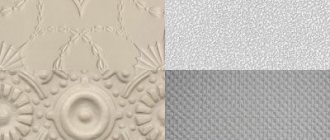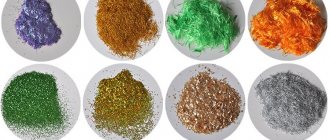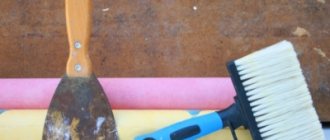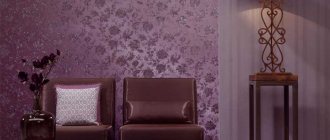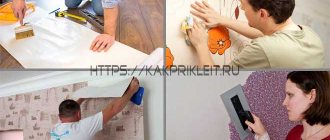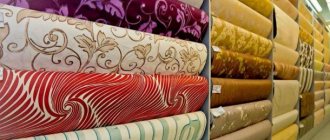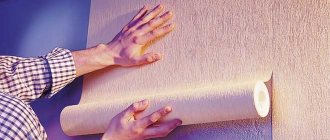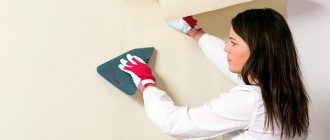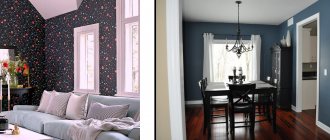Are non-woven wallpaper harmful?
Without a doubt, wallpaper is the most popular way to decorate walls.
Until recently, only paper ones were presented on the market. They were produced in various colors; you could choose wallpaper with any pattern. The only significant drawback was the difficulty in gluing - the canvases swelled and often tore. Repairs had to be done every 3-4 years, since it was impossible to clean the wallpaper; it quickly faded and took on an unpresentable appearance.
Now the industry pleases consumers who decide to do renovations with new types of wall coverings: vinyl on paper or non-woven backing, non-woven wallpaper and others. And questions began to arise more and more often: how harmful or safe are these coatings, how convenient are they to apply and use?
What is non-woven fabric
It would seem that non-woven fabric is a new material, but this is not entirely true. It is successfully used in light industry for sewing outerwear, as it retains the shape of the product. In other words, it is an adhesive lining.
Non-woven fabric consists of two types of fibers: textile and cellulose. During production, they were placed one on top of the other, rolled out and secured with glue. Of course, this explanation is schematic. In fact, the manufacturing process is long and complex.
In the household, many things are made either from non-woven fabric or based on it. These include ordinary kitchen oilcloths, packaging, and perhaps even your holiday tablecloths are made from it. Who hasn’t drank tea brewed in a cup with a bag?
Is it worth talking about the health hazards of non-woven fabric? The base material is not, but the top coating can often cause negative reactions in the body. Therefore, wallpaper made entirely from non-woven fabric does not cause harm to health.
Non-woven wallpaper
Before asking the question about the dangers of such wallpapers, you need to find out which of them exist on a non-woven basis:
- paper;
- vinyl;
- non-woven.
The first type is a base and top paper layer. Such coatings have many advantages. This is air and vapor permeability. They “breathe” without creating negative effects on the microclimate of the room.
But with all the advantages, there are a number of disadvantages that must be taken into account when choosing them:
- short-lived, repairs must be done every 3-4 years;
- mechanical vulnerability, quickly breaks with minor damage;
- are not resistant to moisture, swell and can peel off;
- do not like large temperature changes;
- quickly fade in sunlight, the aesthetic component is lost.
Vinyl wallpaper with non-woven backing is very attractive to consumers. Available in several types:
- foamed vinyl. Various relief designs are applied to them. Good for decorating hallways or additional room decor.
- smooth or “kitchen” wallpaper. They have a dense, well-leveled surface, ideal for gluing in bathrooms, hallways or kitchens.
- silkscreen printing. Using silk threads, an exquisite pattern is applied that resembles a fabric surface. Ideal for living rooms and bedrooms.
Important! This type of coating must be purchased by checking the certificate of compliance with the standards for the goods sold in the store where you decided to purchase wallpaper for gluing.
Unscrupulous manufacturers may use components that can harm the health of the buyer who decides to hang such wallpaper. Therefore, when purchasing, you need to make sure that they are safe for yourself and your loved ones. To do this, ask for quality certificates from sellers.
Non-woven wallpaper on a non-woven basis is the most expensive, but also one of the safest types of wallpaper of all those listed. They will not cause harm to health if they are glued to the walls.
Both layers are made of this material. The bottom “lining is made of a less dense, lightweight kind. The top one is heavy, structured, with a pressed texture.
High-quality non-woven wallpaper is expensive, so if your budget is limited, you should think about cheaper options.
What you need to know about glue
Do not forget about the correct selection of glue for non-woven wallpaper. Sometimes it can cause a more severe allergic reaction than untested wallpaper.
Attention! Usually the wallpaper roll will give a recommendation on the type of adhesive to use. When purchasing high-quality material for gluing, you must also purchase appropriate glue, without skimping on your health. You need to choose based on the safe composition, and not the price level.
The instructions for gluing wallpaper usually specify the method of application and the drying time of the glue. The longer it dries, the more harmful substances are released into the environment. People prone to allergic reactions should not stay in such a room for a long time.
Harmful or not
It has already been established that paper and non-woven wallpapers do not harm human health. It is worth understanding the harm of vinyl.
Vinyl contains formaldehyde. But harmful fumes of this substance occur only with significant heating, that is, during a fire.
At normal room temperature, there cannot be any harmful fumes from vinyl wallpaper. Moreover, formaldehyde is a component of finishing materials such as linoleum, carpet, and plastic windows. Most likely, there is not a single apartment where these finishing materials are not used.
In everyday life, we are surrounded by many objects that contain formaldehyde during production. But no one throws things into a landfill and has no intention of doing so.
But it is worth noting that if there is a person in the family who is prone to allergic reactions or a small child, then it is better to avoid buying non-woven wallpaper with a vinyl top layer for renovation.
Some skeptics argue that vinyl wallpaper has such a dense structure that it does not “breathe,” which is certainly harmful to health. Recently, the production of foam wallpaper with micropores, which are vapor- and air-permeable, has begun.
Important! The largest manufacturers of wall finishing materials carry out appropriate certification for the safety of vinyl wallpaper intended for residential premises.
In conclusion, you can watch a video on the choice, advantages and disadvantages of non-woven wallpaper:
Source: https://2proraba.com/steny/oboi/vredny-li-flizelinovye-oboi-dlya-zdorovya.html
We study the pros and cons of non-woven wallpaper
Like any other material, this type of wallpaper has its advantages and disadvantages. In order to understand how high-quality and practical the decorative material in question is, it is necessary to consider all its sides, both positive and negative.
Pros:
- durable material. It will serve you for many years, and will remain in its original form for many years;
- environmentally friendly wallpaper, it does not contain any harmful impurities or compounds. So you don’t have to worry about the health of household members with such coating on the walls;
- the structure of non-woven wallpaper is quite dense, which means the coating can be called reliable;
- fire resistance. This criterion is one of the main ones, which is an advantage, because it means that with such coverage you will feel safe;
- installation is simple and does not require special skills and knowledge;
- It is very easy to care for this coating. It can be washed and dusted off without damaging the surface structure.
The advantages of non-woven wallpaper also include the fact that they can be glued even to not very smooth walls, to surfaces with some small defects. This way, you will have the opportunity to save money and time on repairs. The wallpaper stretches a little, and also does not get wet from the adhesive composition, like paper.
Minuses
Any material, object, even a person has disadvantages, so non-woven wallpaper, pros and cons in this case, is no exception:
- if the surface of the wallpaper is embossed, it will collect dust on itself, especially this drawback worries people with allergies;
- when you choose such wallpaper, you should also take into account the fact that relief always attracts small children, as well as animals that are in the house, they tear and tear them, so take this into account;
- if you buy non-woven wallpaper in order to paint it, the costs will increase, because you will also have to purchase paint for it;
- the price of such wallpaper is higher. Compared to the cost of conventional paper, this criterion often gives an advantage to other types of wallpaper;
- wet cleaning will also have to be carried out on the surface of the embossed wallpaper, which will take a lot of time, especially if this kind of coating is on the surface of more than just one room.
Features and advantages of non-woven wallpaper video
Having examined in detail the pros and cons, purpose and features, you can already draw your own individual conclusions on this matter. There are a number of advantages and some disadvantages that can sway the consumer in one direction or the other. Whatever option you choose, the main thing is that it is balanced, objective, and subsequently that you do not regret it.
Vinyl wallpaper - are they harmful to human health?
Currently, the choice of wallpaper is not just great, it is huge! And not the least of them is vinyl. But you should understand that in addition to beauty, the material must also be safe. Let's try to find out how harmful vinyl wallpaper is to human health.
Types of vinyl wallpaper - the advantages of chemistry
Before we figure out whether vinyl wallpaper is harmful or not, let’s explore what types they are divided into. So, the division of wallpaper into different categories depends on what material their surface and bottom layers are made of. There are vinyl wallpapers on the following bases: paper, non-woven and fabric.
Preference is given to a non-woven base, as it gives the wallpaper such properties as lightness and strength. In addition, they also help to increase the level of sound insulation (which is not typical for other types). It is worth noting that this wallpaper can be glued to the walls of a new house. They are not afraid of possible shrinkage of the timber and various cracks on the surface of the walls.
Based on the type of surface, vinyl wallpaper is also divided into embossed, embossed, smooth and silk-screened. When choosing among those listed, it is worth highlighting the relief ones.
They have a voluminous, dense coating that will hide various wall defects or unevenness.
But you should pay attention to the fact that embossed products are most susceptible to all kinds of damage, so you need to handle them with extreme care and caution.
The main priority of vinyl wallpaper is that it allows you to decorate your walls in the form of imitation of various coatings: granite, marble, ceramics and all sorts of patterns. Perhaps this is due to the huge selection of patterns and materials. In addition, vinyl coating can be washed, which will keep the walls of your home perfectly clean!
Vinyl wallpaper is harmful to health - where did this opinion come from?
So, let’s look at the issue of the harm of vinyl wallpaper, or rather, where this assumption came from. This material has two layers. The bottom one, which we talked about above, can be made of paper, fabric or non-woven fabric. There are no complaints about him.
It's all about the top layer, which consists of polyvinyl chloride (PVC). It is this mysterious word that worries our compatriots so much. Indeed, polyvinyl chloride is clearly a chemical compound, and chemistry is harmful to human health in most cases. But are vinyl wallpapers harmful, are they dangerous for us and our body?
It is worth noting that there is some truth in this opinion. Polyvinyl chloride has the property of being waterproof. On the one hand, this is a big plus; the walls are easy to care for, they can be washed without any danger.
But the downside here is that the air exchange in the room is disrupted; the wall covering simply does not allow air to pass through.
The impermeability of vinyl wallpaper provokes the formation of harmful and dangerous fungi that form on the wall underneath.
In addition, according to doctors, a person may develop allergies if the sheets evaporate toxic fumes of formaldehyde. But don’t panic, this only applies to cheap Chinese fakes stuffed with chemicals.
Therefore, when choosing, pay attention to the manufacturer, do not try to save on quality and, consequently, on your health.
Chinese vinyl wallpaper - why are they dangerous?
A person knows how to adapt to everything, modernize and do what previously seemed impossible. New generation vinyl products have passed this stage. It consists in eliminating all the disadvantages and increasing the advantages.
Manufacturing specialists came up with a technology that made wallpaper “breathable”. In this case, the PVC layer is made with many micropores that allow air to pass through.
As mentioned above, it is worth choosing quality manufacturers. After all, they are the ones who have already implemented this technology, which does not apply to counterfeits from China.
In European countries, they carefully monitor the environmental safety of vinyl wallpaper batches produced and maintain strict control.
We advise you to choose wallpaper made in Germany, Finland and Great Britain. Manufacturers in these countries add an antifungal component to the wallpaper, which will protect you from the possible development of harmful microflora. In a word, the improved production system allows us to confidently state that modernized vinyl wallpapers do not pose a danger to human health.
How to make the right choice of wallpaper?
So, we have figured out that vinyl wallpaper is harmful to health only in cases where we save on purchases. Now let's learn how to choose this product correctly in stores. First, having chosen the wallpaper sample you like, take the roll in your hands and unwind it a little. Imagine this wallpaper on the wall of your room, feel it for strength.
If you are still afraid of a fake, from which toxic substances may evaporate, then charm will help you! Smell the unwound roll. If you smell a sharp, unpleasant smell of chemicals, you should not buy it. To buy vinyl wallpaper that is safe for health, it is best to go to specialized stores.
As a rule, all wallpaper there is environmentally friendly and certified. It’s better to overpay a little than to poison your body with chemical fumes by buying a fake. In addition, if after the repair you are left with an unclaimed roll that you did not even unwind, you will be refunded for it by check.
By the way, on our website you will find a detailed description of how to glue vinyl wallpaper.
We draw conclusions - harm or not
It should be noted that most building materials are currently made from certain chemical elements. This applies to plastic windows, suspended ceilings, wiring insulation and even the bags in which we put food! All of the listed objects contain polyvinyl chloride, which some people are so afraid of.
Don't beat yourself up so much about this. But you should analyze the information! For example, experts say that truly dangerous fumes come from chipboards. And, as we know, almost all furniture is currently made from them!
But if you are still tormented by vague doubts, do not glue vinyl wallpaper in the bedroom and nursery. Decorate with them the walls of well-ventilated rooms where there is no high humidity. This could be a corridor, a hall, a spacious living room or an office.
And the remaining rooms, where you spend most of your time, can be covered with simple paper wallpaper or more expensive and high-quality bamboo and cork products.
They are made from plant ingredients that do not contain chemicals.
Let us repeat once again the main points when choosing vinyl wallpaper:
- Don’t skimp on quality manufacturers; choose the material wisely.
- Carefully read the label, which indicates the composition, production, etc.
- Don't buy vinyl wallpaper if it has a strong, chemical smell. High-quality material, even if it is the cheapest, will not smell of chemicals.
- Ventilate your apartment regularly. Provide rooms with walls covered with vinyl wallpaper with the necessary flow of fresh air.
- Make sure that there is no excessive humidity or dampness in the apartment.
Source: https://komfortnyeokna.com/vinilovye-oboi-vredny-opasny-zdorovja.html
How not to get confused when choosing
In order to understand the abundance of different colors, textures and characteristics in the store, you need to understand what types of non-woven wallpaper there are.
Non-woven fabrics are a multi-layer material, the base of which is non-woven, and the second layer can be anything: textiles, vinyl or paper
This finishing material is classified into two main types:
- Fabrics with a non-woven base. This wallpaper has two specific layers. The first, bottom layer is non-woven fabric, which is applied to the wall during gluing. The second, top layer, can be made of a variety of materials: paper, textiles, vinyl. The outer layer performs a purely decorative function.
- Non-woven wallpaper, which consists of several layers of non-woven material. The surface layer is usually made textured, protruding, with decorative patterns or ornaments. All other layers are smooth. This type is often used for painting, which can be repeated more than once. The textured top layer gives such wallpaper a luxurious appearance and makes it convenient for implementing any design solutions.
Non-woven wallpapers have a lot of advantages compared to those made from other materials; they have almost no disadvantages. High strength, excellent characteristics, richness of patterns, textures, and the ability to experiment with colors make them the most practical and convenient for use in a wide variety of interiors and styles. If you decide to purchase non-woven wallpaper for your renovation, you will receive a beautiful, high-quality wall finish that will last for many years. And when you get tired of the coating, it will be quite easy to replace it with another one. This is convenient for those who are constantly striving for some kind of change.
Vinyl wallpaper on paper and non-woven backing - features of selection and gluing
The choice of finishing material when performing repair work is not a trivial task, so a sufficient amount of time should be devoted to solving this issue. With all the abundance of products of this type on the market today, making the right choice will be quite problematic. When using a certain variation of wallpaper, it is necessary to take into account the microclimate created in the room. If certain difficulties arise when making a choice, it is best to consult with a specialist. Vinyl wallpaper - a worthy choiceVinyl wallpaper is very popular today. This material appeared relatively recently, but has already managed to occupy its niche in the market. High resistance to temperature fluctuations and high humidity significantly expands the scope of application of this type of wallpaper. |
They can even be used in such specific rooms, which include:
- kitchen;
- bathroom;
- hallway;
- hall.
Vinyl wallpaper comes in a variety of designs, textures and colors. This finishing material consists of two layers. A polyvinyl chloride coating is applied to a paper or non-woven base.
A drawing or pattern is implemented on top. Such wallpaper may contain antifungal components, which significantly increase the overall service life of the product and prevent the formation of mold.
The polyvinyl chloride layer of vinyl wallpaper is able to withstand pollution and various mechanical damage. All this greatly simplifies the operation of the material, because to clean the coating it is enough to wipe it with a damp cloth or rag.
↑
Modern methods of manufacturing vinyl wallpaper ensure that the finishing material used is characterized by increased strength and reliability of operation, as well as maximum service life. The top layer of the product can be decorated in various ways. According to the production method, such wallpapers are divided into products made on the basis of foamed vinyl with or without embossing.
Screen-printed vinyl wallpaper is made by applying vinyl paste to a paper backing. After this, the material is subjected to heat treatment in a special oven. In this case, gas acts as a filler. During its evaporation, the process of pore formation occurs.
This structure can ensure the longest possible service life of the finishing material. With proper care, vinyl wallpaper can last at least fifteen years.
There is another variation of vinyl wallpaper, which is made using the hot stamping method. A paper blank with a printed pattern is placed in a special oven. Subsequently, it is processed under the influence of high temperatures.
The top layer melts and is tightly embedded into the structure of the material. As a result, you can get different variations of textures and patterns.
Important! Heat treatment removes various harmful substances from the material, making it absolutely safe for the human body.
There are several types of vinyl wallpaper, the decorative layer of which is applied using hot stamping. Moreover, the differences lie not only in the method of applying the image, but also in the final density of the material.
| Variation of material and method of drawing | Density, g/m2 | Characteristics |
| Silkscreen printing | 90-130 | Such wallpapers are characterized by minimal weight indicators. The applied layer of polyvinyl chloride is also minimal. The surface of the wallpaper is smooth with a silk effect. |
| Compact vinyl | 150-200 | The material is more dense. Its distinctive feature is the ability to imitate textile or stone coating. |
| Heavy vinyl | From 250 | The densest material variation. The vinyl layer in this case will be as thick as possible. These wallpapers are distinguished by their textured surface and the ability to smooth the wall surface. |
More recently, another method was invented. We are talking about chemical embossing. Its essence lies in the fact that initially special substances called inhibitors are applied to the paper base. They are responsible for creating the image on the surface of the wallpaper. The main feature of such substances is that they prevent foaming.
When placed in the oven, the vinyl layer gradually foams and increases in volume. But the areas with inhibitors remain unchanged. Ultimately, the applied pattern is characterized by extreme strength, as well as resistance to direct sunlight and high moisture. This variation of the material is very well suited for finishing kitchens and bathrooms.
↑
To make vinyl wallpaper, a traditional paper or non-woven base can be used. In the latter case, the polyvinyl chloride mass is applied to a layer of non-woven fabric. This is the name of non-woven material for the manufacture of which cellulose and textile fibers were used.
The individual elements are connected to each other by a special connecting link. Non-woven fabric can give wallpaper any shape, so here we can talk about a wide choice of textures.
Advantages
Vinyl wallpaper on a non-woven basis has a number of advantages. This material can hide all the small irregularities of the wall. In addition, it is characterized by extreme ease of installation and further operation.
During the pasting process, such wallpaper is not subject to deformation, so there are no particular difficulties in solving this issue. This variation of the material can be used for finishing the walls of rooms with high levels of humidity.
Flaws
The main disadvantage of non-woven wallpaper is the high level of price indicators that characterize products of this type.
This state of affairs is due to the fact that interlining is not produced on the territory of the Russian Federation, as a result of which there is a need to import this product.
Features of use
Considering the fact that vinyl is positioned as a synthetic coating, the issue of its toxicity is not without its relevance. Along with this, polyvinyl chloride is used quite often today, so you should not be too afraid of the negative consequences of the material used.
The only thing you should focus on when purchasing is the presence of a certificate confirming the high quality of the product. If the seller cannot present it, then it is best to refuse the purchase.
Useful. Which wallpaper is better, vinyl or non-woven - read in a separate review.
↑
The process of gluing walls using vinyl wallpaper on a non-woven backing should not be difficult. It is best to resolve this problem in several stages. You should be careful when preparing the wall surface.
Stage No. 1. Preparing wallpaper
The first part of the preparatory stage is the correct selection of wallpaper that will be used as a finishing material. It is first necessary to make all the relevant measurements and only after that make a purchase. Before gluing, the wallpaper should be positioned in such a way that the applied pattern is complete.
Stage No. 2. Preparing the wall
The essence of the second stage of work is to prepare the wall surface. In this case, it may be necessary to remove the old covering if the renovation is not carried out in a newly purchased apartment.
At this stage, it may be necessary to resolve the following issues:
- Dismantling the old covering.
- Removing irregularities.
- Puttying.
- Surface priming.
- Drying before gluing.
It is possible that you will have to resort to the use of antifungal drugs, which can slightly increase the overall service life of the finishing material.
Stage No. 3. Wallpapering
After leveling the surface, you can begin the actual procedure of wallpapering the walls. The peculiarity of the procedure is that the adhesive mixture is applied not to the material, but to the wall. For better fixation, you can slightly blot the edges of the roll.
The adhesive solution is applied to the wall using a roller. It is recommended to work from window to door.
It should be taken into account that such wallpaper has a fairly high stretch coefficient, as a result of which drying may be accompanied by shrinkage of the material.
In this context, it is necessary to carefully approach the markup, making allowances for this property. The wallpaper must be smoothed from top to bottom, and if the pattern is selected, from the middle to the edges.
Advice! If, in the process of pasting walls with vinyl wallpaper on a non-woven basis, it becomes necessary to remove the implemented layer, it is recommended to first remove the polymer coating, and only then get rid of the paper base.
↑
Paper base for wallpaper is the most common option. Various coating variations can be applied to it. The most popular of them are presented below:
- textile;
- cork;
- vinyl;
- paper.
Two-layer paper wallpaper has many advantages, and if vinyl is used as the top layer, the performance characteristics of the material will be even better. The scope of application of such wallpaper is also quite wide.
Advantages and disadvantages of use
Like any other wall covering, non-woven wallpaper has its pros and cons.
The advantages of this coating are the following:
- can be painted. The surface is textured and often has some kind of pattern or ornament, which gives them a resemblance to decorative plaster. You can change the style of your interior several times, and there is no need to re-paste the wallpaper. Water-based paints are most often used for painting canvas;
- The top layer of wallpaper can be covered with vinyl, which does not fade or fade. This finish will serve you for many years without losing its ideal appearance;
- You can remove the surface layer during repairs. The non-woven base remains on the wall, making it more even and smooth, which is a big plus for those who do not have the opportunity to level the walls;
- the coating can be cleaned from dust using a vacuum cleaner or cloth;
- To hang wallpaper, you only need to apply glue to the wall. You don’t have to smear the canvas with glue and wipe off the excess from the floor.
Non-woven wallpaper has many advantages, one of which is reusable painting
- the surface layer is easily damaged, dents and scratches may remain on convex patterns;
- the cost is much higher compared to paper options;
- Another disadvantage is that dust often accumulates in the recesses of textured patterns.
As you can see, there are much more advantages than disadvantages.
Are vinyl and non-woven wallpapers harmful? Experts' answer
Many have already asked this question: is there any harm in wallpaper, namely non-woven and vinyl? And for good reason. In this article, we will tell you the expert opinion based on research.
Damage to vinyl wallpaper
Harm of non-woven wallpaper
Real non-woven wallpaper does not cause harm and is a high-quality finishing material, but nowadays the manufacturer, in order to reduce the cost of its product and be more competitive in the materials market, uses some tricks. Some vinyl wallpapers on a non-woven basis have been invented, which are called “non-woven”.
It is this vinyl that is dangerous to human health. As a result of combustion, it releases formaldehyde, which in turn reacts with human blood, causing irreversible consequences in the organs.
Here are the organs that are negatively affected by formaldehyde: the central nervous system, skin, respiratory tract, reproductive organs, pathological changes in genetic material.
Ingestion of 70 to 90 ml of formaldehyde is fatal.
The glue selected for gluing non-woven wallpaper can also be dangerous. It is important to approach the choice of glue seriously and responsibly, check the manufacturer, read the instructions, and consult with experts in this industry. After repair work, it is important to thoroughly ventilate the room before using it for domestic purposes.
Be especially careful when choosing wallpaper. Well-known manufacturers value their reputation by constantly conducting relevant research.
Before purchasing wallpaper, be sure to ask the seller if there is a certificate of conformity and a sanitary-epidemiological certificate for the product.
A conscientious seller will certainly satisfy your curiosity by providing such documents.
You should also pay attention to the structure of the wallpaper. Real non-woven wallpaper has a hard and dense texture, which cannot be said about a fake. Their texture is soft and easily damaged when pressed, for example with a fingernail.
And the most harmless of the negative factors of such wallpapers can be called their tendency to accumulate dust in residential and office spaces - this happens due to the textured surface of the wallpaper. This is felt especially acutely by asthmatics, people with respiratory diseases, and allergy sufferers. This problem can be solved by frequent wet cleaning of surfaces where such wallpaper is pasted.
When choosing wallpaper, look for special characteristics such as breathability (“breathable wallpaper”). The absence of this property contributes to the appearance of a fungus that is dangerous to health.
Technical characteristics of non-woven fabric
Non-woven wallpaper has special technical characteristics. Non-woven fabric is a specific non-woven material made from cellulose and textile fibers, which is bonded with a polymer. To obtain it, the fiber pressing method is used. In its appearance, this material is a little similar to ordinary paper, but has an increased density and allows you to implement a variety of ideas, thanks to the ability to produce a huge number of textures, designs and patterns. The structure of non-woven fabric is amorphous, it does not stretch.
During the gluing process, non-woven wallpaper is not subject to deformation, and there is no shrinkage if it gets wet. This type of canvas is perfect for gluing to walls that have unevenness and cracks; they adhere well to surfaces made of cardboard, plywood, plasterboard, and porous concrete. Compared to paper, non-woven fabric has higher fire resistance.
Which wallpaper base is better: paper or non-woven fabric?
Non-woven-based wallpapers are in many ways superior to paper-based wallpapers, but they are more expensive. Is it worth overpaying? What are the differences between paper backing and non-woven backing?
- 1 of 2
On the picture:
Attention, substrate! As we wrote in a previous article, the basis of the wallpaper determines the gluing technology: spread the glue on the canvas or just on the wall. There are wallpapers on a paper basis (backing) and on a non-woven basis.
What kind of wallpaper is this?
Before you get to the bottom of the truth and understand whether non-woven wallpaper really causes damage to our health, you need to know exactly what they are made of. Having started collecting material, you can almost instantly understand that we are making a huge mistake by calling all wallpaper that contains even a drop of non-woven wallpaper non-woven. In fact, this is completely wrong.
Is there any harm from wallpaper?
There are different types of wall coverings on store shelves, and not all of them are actually non-woven. Most are a mixture of interlining and something else, such as paper or vinyl. And this, excuse me, is a completely different tune. Well, let's start in order and dot the i's. Let's lift the veil of secrecy over the new material and find out whether it can be trusted.
Real non-woven wallpaper
Non-woven fabric is a long-known non-woven material. It consists of textile and cellulose fibers interconnected. These fibers are held in place not by weaving, as is the case in textile fabrics or knitwear, but by polymers. Roughly speaking, they took two types of threads, placed them on top of each other randomly, smoothed them into a thin fabric, and then fastened them together by filling them with glue. So the result was non-woven fabric, which is still used in tailoring.
